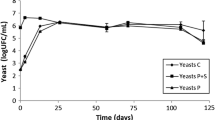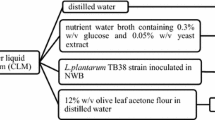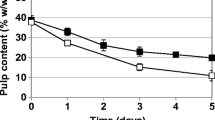Abstract
The results of an experimental trial, carried out using a specifically prepared microbial starter, in an automated pilot plant, are presented. The microbial starter was composed by Lb. pentosus strains. The automatized process was compared with natural fermentation in plastic vats, as control. Relevant process parameters, chemico-physical determinations, instrumental texture, and microbiological analyses were carried out to monitor the fermentation process. Driving the process in controlled conditions resulted in a more rapid acidification, pH reaching lower values than the control. In controlled conditions, inoculated lactobacilli carried out a fast colonization supplanting more rapidly spoilage microflora. In started samples, yeasts number increased until reaching 5 log at 60 days, keeping this value constant until the end of the trials, while, in control batches, their growth was more rapid, reaching 5 log from 15 to 30 days, but their number decreased to 3 log at 90 days. The two processes produced olives with comparable texture profile. However, olives coming from the controlled process resulted debittered in 3 months (descriptive sensory analyses and oleuropein quantification in HPLC), while naturally fermented olives resulted not yet debittered at the end of the trial (180 days). Slight differences were found in few other sensory descriptors. Our results showed that, along with the use of effective autochthonous microbial starters, the innovation of processing plants is the next step towards the shortening of the processing time and the safety assurance of the product, while retaining the sensory quality of naturally fermented olives, using an environmentally friendly technology.







Similar content being viewed by others
References
Akbarian, M., Ghasemkhani, N., & Moayedi, F. (2014). Osmotic dehydration of fruits in food industrial: A review. International Journal of Biosciences, 4(1), 42–57.
Bevilacqua, A., de Stefano, F., Augello, S., Pignatiello, S., Sinigaglia, M., & Corbo, M. R. (2015). Biotechnological innovations for table olives. International Journal of Food Science and Nutrition, 66, 127–131 1-5.
Campus, M., Sedda, P., Cauli, E., Piras, F., Comunian, R., Paba, A., Daga, E., Schirru, S., Zurru, R., & Bandino, G. (2015). Evaluation of a single strain starter culture, a selected inoculum enrichment, and natural microflora in the processing of Tonda di Cagliari natural table olives: impact on chemical, microbiological, sensory and texture quality. LWT–Food Science and Technology, 64, 671–677.
Cardoso, S. M., Guyo, S., Marnet, N., Lopes-da-Silva, J. A., Renard, C. M. G. C., & Coimbra, M. A. (2005). Characterization of phenolic extracts from olive pulp and olive pomace by electrospray mass spectrometry. Journal of the Science of Food and Agriculture, 85, 21–32.
Coimbra, M. A., Waldron, K. W., Delgadillo, I., & Selvendran, R. R. (1996). Effect of processing on cell wall polysaccharides of green table olives. Journal of Agricultural and Food Chemistry, 44, 2394–2401.
Contreras, J. E., & Smyrl, T. G. (1981). An evaluation of osmotic concentration of apple rings using corn solids solutions. Canadian Institute of Food Science Technology Journal, 14, 310–314.
Corsetti, A., Perpetuini, G., Schirone, M., Tofalo, R., & Suzzi, G. (2012). Application of starter cultures to table olive fermentation: an overview on the experimental studies. Frontiers in Microbiology, 3, 1–6.
Di Cagno, R., Coda, R., De Angelis, M., & Gobbetti, M. (2013). Exploitation of vegetables and fruits through lactic acid fermentation. Food Microbiology, 33, 1–10.
Fadda, C., Del Caro, A., Sanguinetti, A. M., & Piga, A. (2014). Texture and antioxidant evolution of naturally green table olives as affected by different sodium chloride brine concentrations. Grasas y Aceites, 65(1), e002.
Friedman, H. H., Whitney, J. E., & Szczesniak, A. S. (1963). The texturometer -a new instrument for objective texture measurement. Journal of Food Science, 28, 390–396.
Garrido-Fernandez, A., Fernandez Díaz, M. J., & Adams, M. R. (1997). Table olives: production and processing. London: Chapman & Hall.
Gutiérrez, F., Albi, M. A., Palma, R., Rios, J. J., & Olías, J. M. (1989). Bitter taste of virgin olive oil: correlation of sensory evaluation and instrumental HPLC analysis. Journal of Food Science, 54, 68–70.
International Olive Council (IOC). (2004). Trade standard applying to table olives. Madrid: IOC http://www.internationaloliveoil.org/estaticos/view/222-standards.
International Olive Council (IOC). (2009). Determination of biophenols in olive oils by HPLC. Madrid: IOC http://www.internationaloliveoil.org/estaticos/view/224-testing-methods.
International Olive Council (IOC). (2011). Method e sensory analysis of table olives. Madrid: IOC http://www.internationaloliveoil.org/estaticos/view/224-testing-methods.
ISO. (2012). ISO 8586:2012. Sensory analysis e general guidelines for the selection, training and monitoring of selected assessors and expert sensory assessors (1st ed.). Geneva: International Organization for Standardization.
Isolini, D., Grand, M., & Glättli, H. (1990). Selektivmedien zum Nachweis von obligat und fakultativ heterofermentativen Laktobazillen. Schweizerische Milchwirtschaftliche Forschung, 19, 57–59.
Kiai, H., & Hafidi, A. (2014). Chemical composition changes in four green olive cultivars during spontaneous fermentation. LWT-Food Science and Technology, 57, 663–670.
Lanza, B. (2013). Abnormal fermentations in table olive processing: microbial origin and sensory evaluation. Frontiers in Microbiology, 4(91), 1–7.
Lawless, H. T., & Heymann, H. (2010). Sensory evaluation of food e principles and practices (2nd ed.). New York: Springer.
Lazarides, H. N. (2001). Reasons and possibilities to control solids uptake during osmotic treatment of fruits and vegetables. In P. Fito, A. Chiralt, J. M. Barat, W. E. L. Spiess, & D. Behsnilian (Eds.), Osmotic dehydratation and vacuum impregnation (pp. 33–42). Lancaster: Technomic Publishing Company, Inc.
Lenart, J. M., & Flink, A. (1984). Osmotic concentration of potato. I. Criteria for the end-point of osmosis process. Journal of Food Technology, 19, 45–60.
MacFie, H. J. H., Bratchell, N., Greenhoff, K., & Vallis, L. V. (1989). Designs to balance the effect of order of presentation and first–order carry–over effects in hall tests. Journal of Sensory Studies, 4, 129–148.
Maldonado, M. B., Zuritz, C. A., & Miras, N. (2008). Influence of brine concentration on sugar and sodium chloride diffusion during the processing of the green olive variety Arauco. Grasas y Aceites, 59(3), 267–273.
Marsilio, V., Seghetti, L., Iannucci, E., Russi, F., Lanza, B., & Felicioni, M. (2005). Use of a lactic acid bacteria starter culture during green olive (Olea europaea L cv Ascolana tenera) processing. Journal of the Science of Food and Agriculture, 85, 1084–1090.
Martorana, A., Alfonzo, A., Settanni, L., Corona, O., La Croce, F., Caruso, T., Moschetti, G., & Francesca, N. (2015). An innovative method to produce green table olives based on “pied de cuve” technology. Food Microbiology, 50, 126–140.
Moreira, R., Chenlo, F., Torres, M. D., & Vazquez, G. (2007). Effect of stirring in the osmotic dehydration of chestnut using glycerol solutions. LWT-Food Science and Technology, 40, 1507–1514.
PanelCheck software (2014). Nofima Mat, Ås, Norway. http://www.panelcheck.com
Phisut, N. (2012). Factors affecting mass transfer during osmotic dehydration of fruits, international. Food Research Journal, 19(1), 7–18.
Servili, M., Minnocci, A., Veneziani, G., Taticchi, A., Urbani, S., Esposto, S., Sebastiani, L., Valmorri, S., & Corsetti, A. (2008). Compositional and tissue modifications induced by the natural fermentation process in table olives. Journal of Agricultural and Food Chemistry, 56, 6389–6396.
Szczesniak, A. S. (1963). Classification of textural characteristics. Journal of Food Science, 28, 385–389.
Tassou, C. C., Panagou, E. Z., & Katsaboxakis, K. Z. (2002). Microbiological and physicochemical changes of naturally black olives fermented at different temperatures and NaCl levels in the brines. Food Microbiology, 19, 605–615.
Tomic, O., Nilsen, A., Martens, M., & Næs, T. (2007). Visualization of sensory profiling data for performance monitoring. LWT-Food Science and Technology, 40(2), 262–269.
Author information
Authors and Affiliations
Corresponding author
Rights and permissions
About this article
Cite this article
Campus, M., Cauli, E., Scano, E. et al. Towards Controlled Fermentation of Table Olives: LAB Starter Driven Process in an Automatic Pilot Processing Plant. Food Bioprocess Technol 10, 1063–1073 (2017). https://doi.org/10.1007/s11947-017-1882-7
Received:
Accepted:
Published:
Issue Date:
DOI: https://doi.org/10.1007/s11947-017-1882-7




